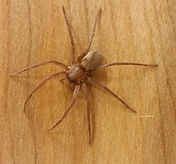



Titiosis Spider
This spider is a species within the genus Titiotus, which is native to California. It is often mistaken for a brown recluse because of the colouring and faint violin shape on the abdomen. Titiotus superfically looks like a brown recluse spider, or desert recluse spider, but isn’t. Titiotus has eight eyes, whereas brown recluse-type spiders have only six. Due to its prominent violin marking and large size, Titiotus is one of the most commonly reported species. The venom of these spiders is not reported as harmful to people. They belong to the spider family Tengellidae includes 57 described species; 41 of these occur in the United States, with 33 of these 41 species having been described by Platnick and Ubick in their revisions of Socalchemmis (2001), Anachemmis (2005), and Titiotus (2008). In the U.S., Licranoides occurs in the Appalachian Mountains (Platnick 1999), Lauricius from Arizona to New Mexico and north into Colorado, and the remaining U.S. genera (Socalchemmis, Anachemmis, and Titiotus) are found in California, with some extension to the north and south (Ubick and Richman 2005).
Titiotus spiders are endemic to California and are often mistaken as I did until kindly corrected by Dana, as desert recluse. I couldn't find any common name for these spiders. Titiotus species seem to prefer steep, rocky canyon slopes near high montane streams. At lower elevations, including the Coast Ranges, Titiotus species occur mostly in forests, especially oak and mixed evergreen, but also in rocky grasslands. These spiders are also strongly cavernicolous; almost half of the known species are recorded from caves, where they may be quite abundant. Their egg sacs are spherical, about 1.5 cm in diameter, with a papery outer covering, and could be found suspended from the ceiling by a thick cord of silk about 1–2 cm long.
All photos are copyright to their owners and may not be reproduced without permission.











